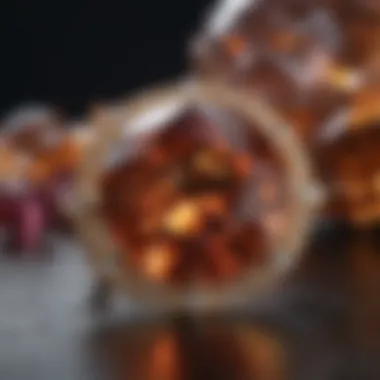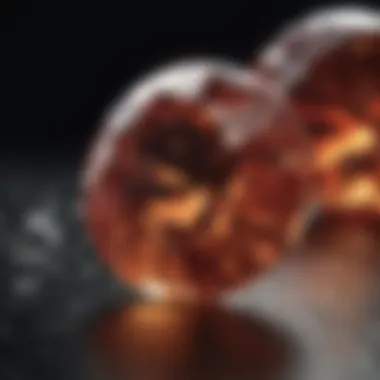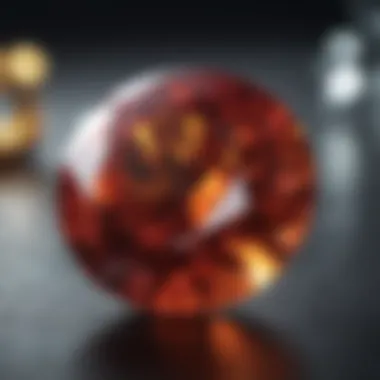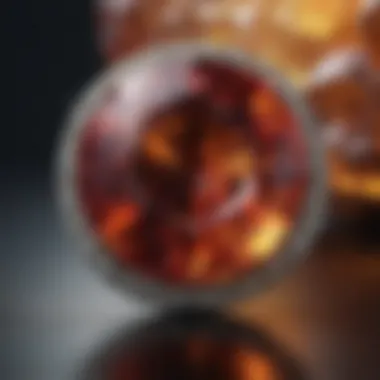Exploring the November 3 Birthstone: Citrine's Rich Legacy


Intro
Citrine is the representative gemstone for those born on November 3. This beautiful yellow stone captures attention not only for its vivid color but also for its rich historical significance and various applications. By delving into the intricacies of citrine, we uncover a multitude of meanings, uses, and properties that resonate across cultures and eras. This exploration aims to shed light on why citrine holds a special place in the hearts of gemstone enthusiasts and global traditions alike.
Gemstone Overview
Description of the gemstone
Citrine is primarily recognized for its yellow to golden-brown hues. Its vibrant color can range from pale yellow to deep amber, striking a balance between brightness and warmth. This quartz variant draws its name from the French word "citrin," meaning lemon. Found in the Earth's crust, citrine is mostly formed from standard quartz undergoing heat treatment.
Physical properties
Citrine possesses several intriguing physical characteristics:
- Mohs Hardness: It measures between 7, indicating good durability, suitable for various types of jewelry.
- Chemical Composition: Composed of silicon dioxide, its formation involves silicon and oxygen.
- Crystal Structure: Belonging to the trigonal crystal system, citrine often appears in a hexagonal shape.
- Optical Properties: The clarity and brilliance of citrine can make it quite alluring, with natural examples showing unique color zoning.
The durability and appealing aesthetics make citrine a sought-after choice among jewelers. Its versatility allows it to complement different styles, from elegant settings to chunky statements.
Healing Properties
Metaphysical attributes
Citrine is often referred to as the "merchant's stone," or a stone of abundance and prosperity. Many believe it promotes financial success and positive energy. It is thought to stimulate the solar plexus chakra, enhancing personal power and confidence.
Common uses in holistic practices
In holistic healing, citrine is believed to:
- Foster creativity and inspiration
- Alleviate feelings of negativity or fear
- Support emotional well-being and clarity of thought
Some practitioners employ citrine in meditation, placing the stone on the solar plexus to balance energy. Others use it in crystal grids to attract positive energies into their environments.
"Citrine's unique vibrational energy can help illuminate one's path toward personal and financial success."
As we understand and appreciate the significance of citrine, it becomes clear why this birthstone resonates deeply with those born on November 3. Its combination of beauty, historical depth, and metaphysical properties constitutes a rich narrative that invites appreciation and exploration.
Preamble to November Birthstones
The topic of November birthstones holds substantial relevance in both cultural and personal contexts. November, characterized by its unique energy and colors, is represented primarily by two stones: citrine and topaz. Each brings distinct qualities that speak to the spirit of the month. This introduction serves as a foundation for understanding why these stones are significant in gemstone lore.
Overview of Birthstones
Birthstones are more than mere ornaments; they possess intricate meanings shaped by history, belief systems, and natural characteristics. The concept of birthstones dates back to ancient times, being associated with the twelve tribes of Israel and the twelve zodiac signs. Each gem reflects a myriad of traits and is believed to enhance certain qualities in individuals born in that month.
Benefits of Understanding Birthstones:
- Cultural Insight: Learning about birthstones connects one to various beliefs and traditions.
- Personal Significance: People often choose gemstones not just for their beauty but for their meanings and potential benefits.
- Jewelry Design: Knowledge of birthstones informs choices in jewelry design, allowing for more meaningful creations.
The Unique Qualities of November
November brings a unique atmosphere, characterized by autumnal changes. The birthstones associated with this month reflect warmth, clarity, and prosperity. Citrine, noted for its vibrant yellow tones, is often linked to wealth and abundance. Meanwhile, topaz can vary in color, offering a broader spectrum of qualities.
Qualities of November Birthstones:
- Citrine: Known for enhancing creativity and confidence, it is also believed to promote joy and invite prosperity.
- Topaz: A stone of love and affection, it is said to help with communication and understanding in relationships.
These attributes make November's birthstones a source of profound meaning and personal expression for those born in this month. Understanding these stones equips enthusiasts, collectors, and designers alike to appreciate their deeper significance.
Identifying the November Birthstone
Citrine: The November Birthstone


Citrine is the primary birthstone associated with November 3. It is a yellow to golden-brown variety of quartz, known for its vibrant hue that resembles sunlight. The color of citrine can range from pale yellow to deep amber, making it a versatile choice for jewelry.
Citrine's origins are significant. Often sourced from Brazil, Spain, and Madagascar, it has been admired for centuries, linked to prosperity and wealth. The ancient Greeks used it as a protective stone, while many in the present day regard it as a stone of abundance. Its clarity and brilliance are also noteworthy. With a hardness of 7 on the Mohs scale, citrine is durable and well-suited for various forms of jewelry.
One interesting fact is that citrine often forms in amethyst deposits, showcasing a beautiful correlation between two distinct gemstones. This feature is appealing to collectors and enthusiasts alike, highlighting the intricate connections within the mineral kingdom.
Alternative November Birthstones
While citrine holds the title as the primary birthstone for November 3, there are alternative stones that also represent this month.
- Topaz: Often associated with love and affection, blue topaz particularly captivates gemstone lovers with its vibrant blue coloration.
- Yellow Sapphire: Known for promoting prosperity and success, yellow sapphire is revered in several cultures for its astrological significance.
Each stone brings its own set of meanings and historical contexts, diversifying the options available to those born in November. Understanding these alternatives provides a broader perspective on personal choices regarding birthstones, enhancing their emotional value.
Geological Properties of Citrine
Understanding the geological properties of citrine enhances our appreciation of this beautiful gemstone. These properties provide insights into the stone’s origin, its characteristics, and how these affect its value in both jewelry and holistic practices. The composition, formation, and distribution of citrine are crucial elements that define the stone's allure and durability.
Formation and Composition
Citrine is a variety of quartz, consisting primarily of silicon dioxide (SiO2). It gains its characteristic yellow to orange hues through the presence of iron impurities. The formation process typically takes place in igneous and metamorphic rocks. When quartz forms from magma or through hydrothermal solutions, citrine emerges under specific conditions involving high temperatures and pressures.
The natural citrine is rare; most available citrine on the market is actually heat-treated amethyst or smoky quartz. Heat treatment involves heating these crystals to elevate their color, transforming their appearance to mimic truly natural citrine. This practice demonstrates the importance of knowing the origin of the gemstone when considering its authenticity and value.
Geographic Distribution
Citrine is found in various locations around the world, with significant deposits in countries such as Brazil, Madagascar, and Spain. Each region contributes unique characteristics due to its specific geological conditions.
- Brazil: Known for producing large, high-quality citrine crystals, often with deep color saturation.
- Madagascar: Offers a range of colors and sizes, known for its exquisite clarity and vivid hues.
- Spain: While not as productive as other countries, Spanish citrine can occasionally be found in local deposits, valued for its unique regional characteristics.
The geographic diversity of citrine underscores its variations and can influence its affordability in the market. This knowledge adds depth to the understanding of citrine not only as a birthstone but also as a collectible gemstone.
Historical Context of Citrine
Understanding the historical context of citrine is crucial for appreciating its significance as the birthstone for November 3. Citrine has been used by various cultures throughout history, often casting a light on human interaction with gemstones and their perceived powers. The journey of citrine reveals insights not only about the stone itself but also about the civilizations that valued it. This background provides a lens through which one can appreciate the depth of its meaning and the nuances between different eras and cultures.
Citrine in Ancient Civilizations
Citrine's allure dates back to ancient civilizations. The Egyptians, known for their love of precious stones, used citrine in jewelry. They believed it had protective qualities. Similarly, in ancient Greece, citrine was believed to be linked to the sun and was favored for its warm color.
In Rome, citrine was considered a stone of wealth. Rings made of citrine were worn by the affluent as symbols of their status. Roman women often adorned themselves with this gemstone to showcase prosperity. The cultural significance of citrine extended beyond aesthetics; it was thought to have healing properties and was used in various spiritual practices.
Citrine Through the Ages
As centuries went by, citrine’s prominence shifted but did not wane. During the Middle Ages, it began to feature in European jewelry. Gemstones were often seen as talismans. Citrine was believed to carry a motivational energy, making it desirable for those in pursuit of success.
In the 19th century, citrine saw a resurgence in popularity in Europe and America. It was embraced for its beauty and affordability compared to other gemstones. The gemstone even became associated with the birthstone tradition in the early 20th century. Various cultures referenced citrine, reinforcing its identity as a stone of prosperity and joy.
"Citrine has transformed throughout history, marking its significance across civilizations from ancient times to modern cultures."
In modern-day settings, citrine continues to be a symbol of brightness and positivity. It finds a place not only in jewelry but also in alternative healing practices, where it is considered a stone of abundance. Its rich history adds layers to its identity, serving as a reminder of the collective human experience surrounding gemstones.
Symbolism and Meaning of Citrine
Citrine is valued not just for its beauty but for the deep meanings associated with it. This birthstone represents various virtues that resonate with individuals born on November 3. Understanding these symbols can enhance the appreciation for citrine and its role in personal and communal practices. Each aspect of citrine’s symbolism contributes to its overall significance, making it a worthwhile subject of exploration.
Wealth and Prosperity
Citrine is often known as the "Merchant's Stone". Many believe that it attracts wealth and prosperity. This belief stems from the warm, cheerful vibes that citrine emanates. The stone is thought to bring a flow of positive energy which can influence one's financial prospects. Many collectors and enthusiasts deliberately wear citrine or keep it close during important business endeavors. The intent is to harness its reputed power for attracting success.
- Individuals involved in trade, finance, or investments frequently choose citrine for its believed ability to enhance clarity and decisiveness.
- The alignment of citrine’s golden hues with abundance makes it a natural choice for those seeking to enhance their economic situation.


In many cultures, the act of gifting citrine is a symbolic gesture of goodwill, aimed at sharing luck with others.
Joy and Energy
Another layer of meaning tied to citrine is its association with joy and vivacity. This stone promotes feelings of happiness, encouraging a positive outlook on life. Those who resonate with citrine often report feeling more energized and enthusiastic about their endeavors.
Citrine’s connections to joy can be examined through the following aspects:
- Mood Enhancement: Citrine is said to help alleviate feelings of depression and anxiety. It can promote emotional balance by dispelling negativity.
- Creativity and Motivation: Many artists and creators wear or utilize citrine to stimulate their creativity and fuel inspiration. Its vibrant energy is thought to enhance innovative thinking.
Encouraging connections among people, citrine is often used in social contexts to facilitate joy-filled gatherings.
Personal Growth
Citrine also holds a space in the realm of personal development. Many believe that it encourages self-improvement and growth. The stone is thought to foster confidence, helping individuals to recognize their own worth and potential.
The aspects contributing to personal growth include:
- Self-Awareness: Those who work with citrine often report heightened self-awareness and clarity about their life goals.
- Overcoming Challenges: Citrine is associated with resilience. It is thought to assist individuals in overcoming personal obstacles and fears.
In contexts of spiritual practice, citrine symbolizes the journey toward enlightenment, making it a favorite among those focused on personal evolution.
Citrine embodies the duality of material and emotional wealth. Its meanings extend beyond mere aesthetics, interweaving with aspects of life that many find significant.
Uses of Citrine in Jewelry
Citrine, renowned for its vibrant hue, holds a special place in the realm of jewelry design. It is not just appreciated for its aesthetic appeal but also for its symbolic properties. The importance of citrine in jewelry extends beyond mere decoration. It serves as a medium of personal expression and charm. Many collectors and jewelers favor citrine because of its radiant color, ranging from pale yellow to deep orange. This versatility allows it to complement various styles and settings in jewelry.
Citrine is frequently used in a variety of jewelry types. Its affordability compared to other gemstones makes it accessible for everyone, leading to its growing popularity. Many individuals choose citrine for birthstone jewelry, particularly for those born in November. Its connection to wealth and prosperity makes it an attractive choice for statement pieces as well.
Types of Jewelry Featuring Citrine
Citrine's utility is broad, with various types of jewelry featuring this alluring stone. Here are some popular forms:
- Rings: From solitaires to elaborate multi-stone designs, citrine rings are popular. They can be casual or formal, suitable for various occasions.
- Necklaces: Pendants with citrine are often designed to showcase the stone's vivid color, creating an eye-catching focal point.
- Bracelets: Citrine stones can be set in bangles or as part of a charm bracelet, adding brightness to any outfit.
- Earrings: Studs, drop earrings, and hoops featuring citrine are often chosen for their ability to catch the light and enhance one's overall appearance.
In addition to these common types, citrine jewelry can also integrate with other stones, creating unique combinations that appeal to diverse tastes.
Design Considerations
When designing jewelry with citrine, several factors come into play. First, the color of the citrine can significantly impact the overall design. Lighter shades of citrine work well in delicate pieces, while deeper hues may be more suited for bold statements.
Next, the cut of the citrine is also crucial. Common cuts include oval, round, and pear, each offering different displays of brilliance. Selecting the right cut to maximize the stone’s natural light reflection can elevate the piece significantly.
Lastly, the choice of metal is essential. Citrine pairs well with yellow gold, which complements its warm tones. Silver and white gold offer a modern touch, making the yellow hues pop even more. Through careful consideration of these elements, jewelers can create stunning pieces that fully showcase the beauty and significance of citrine.
Citrine’s brightness not only enhances jewelry design but also symbolizes positivity and energy, resonating deeply with those who wear it.
By understanding these various uses and design considerations, individuals can appreciate the versatility of citrine in jewelry, making informed decisions whether for personal wear or collecting.
Healing Properties of Citrine
The healing properties of citrine are often discussed among gemstone enthusiasts and practitioners of alternative medicine. This section examines both the emotional and physical healing claims associated with citrine, understanding its purported benefits and considerations. The allure of citrine extends beyond its aesthetic appeal; it has been valued for centuries for its potential to inspire well-being, positivity, and vitality.
Emotional Healing
Citrine is frequently referred to as the "stone of happiness." This reputation is linked to its vibrant yellow and orange hues, which are thought to radiate warmth and energy. Many users believe that citrine can balance emotions, helping to release negative energy and promote a state of calmness. It is often used in meditation practices to facilitate clarity of thought and to foster self-confidence.
Some specific benefits of citrine in emotional healing include:
- Stress Relief: Proponents claim that citrine can alleviate feelings of stress and anxiety, allowing individuals to approach challenges with a positive mindset.
- Boosting Self-Esteem: Many affirm that carrying or wearing citrine enhances self-worth and encourages confidence.
- Empowerment against Negativity: Individuals struggling with pessimism often turn to citrine, as it is believed to dispel negativity and enhance motivation.


The belief in citrine's emotional healing is not universal, but its use in spiritual practices and personal growth has garnered attention in holistic circles. While scientific evidence supporting these claims is limited, many individuals report subjective improvements in mood and emotional balance.
Physical Healing Claims
Beyond emotional benefits, citrine is also attributed with various physical healing properties. Some advocate for its use in addressing specific health issues. These claims, however, should be approached with caution, as they often lack rigorous scientific validation.
Some commonly mentioned physical healing claims of citrine include:
- Enhancing Digestion: Some suggest that citrine can aid in digestive processes and metabolism, potentially contributing to overall health.
- Detoxification: Citrine is often associated with cleansing energies. Thus, it is thought to assist the body in eliminating toxins.
- Energy Boost: Users often claim that citrine can increase physical energy levels, which may help combat fatigue or lethargy.
Despite these claims, it is important to remember that citrine should not replace conventional medical treatments. Instead, it can be viewed as a complementary practice, supporting mental and emotional wellness rather than serving as a miracle cure.
As we continue to explore the significance of citrine, understanding its proposed healing properties provides valuable insight into the perspectives held by gemstone enthusiasts and practitioners alike.
Citrine in Modern Culture
Citrine holds a notable place in contemporary culture, reflecting its evolving significance beyond mere aesthetics. This gemstone, with its warm golden hues, attracts attention in both jewelry and fashion. Understanding its current relevance can deepen appreciation for citrine as a multifaceted symbol.
Citrine in Fashion
Citrine has seen a rise in popularity within the fashion industry. Designers often incorporate this vibrant stone into their collections, recognizing its potential to add elegance and warmth to designs. Furthermore, jewelry featuring citrine is preferred for its versatility; it complements various styles, from casual wear to high-end fashion.
- Color Coordination: Citrine pairs well with earthy tones, making it a great choice for autumn collections.
- Celebrity Endorsement: Many celebrities wear citrine jewelry, thus elevating its status among fans and collectors.
The choice of citrine as a focal point in accessories can assert individuality and confidence.
Citrine in Spiritual Practices
In many spiritual practices, citrine is revered for its potential energetic properties. Practitioners of crystal healing often use this gemstone to enhance positive energy and abundance.
- Manifestation: It is believed that citrine can support intentions related to wealth and success.
- Emotional Balance: Some advocate that citrine fosters emotional stability, making it a valuable aid for practitioners seeking balance in their lives.
Regular meditation with citrine might prove beneficial for those exploring deeper aspects of their spiritual journey.
"Citrine not only dazzles the eyes but is also thought to invigorate the spirit."
Citrine's role in modern spiritual practices highlights its importance as more than just a decorative gem; it serves as a tool for personal growth and exploration.
Caring for Citrine
Caring for citrine is essential to maintain its beauty and longevity. Given its significance as the birthstone for those born on November 3, understanding how to properly handle and care for this vibrant gemstone can enhance its appeal. This section highlights practical cleaning practices, maintenance tips, and effective storage solutions to keep citrine looking its best.
Cleaning and Maintenance
Cleaning citrine is a straightforward process that requires minimal effort but yields great rewards. To clean citrine effectively,
you should utilize a soft cloth and warm soapy water. Here are some important points to note:
- Soft Cloth: When wiping down citrine, opt for a lint-free cloth. This helps prevent scratches on the surface.
- Mild Soap: Choose a mild soap solution to avoid any harsh chemicals that could damage the stone.
- Avoid Strong Chemical Cleansing Agents: Citrine can be sensitive to acidity and abrasiveness, so avoid cleaners known for their strong chemical compositions.
- Moderate Heat Exposure: While citrine is a hard stone, excessive heat can lead to cracks. Keep it away from extreme temperatures during cleaning.
Following these cleaning principles can preserve the clarity and brilliance of citrine, allowing it to shine brighter in jewelry pieces.
Storage Recommendations
Proper storage of citrine plays a crucial role in preventing damage and ensuring it stays in pristine condition. Consider these storage recommendations:
- Separate Storage: Store citrine in a soft pouch or a separate compartment in a jewelry box. This avoids contact with harder gems that may scratch its surface.
- Controlled Environment: Keep citrine in a cool, dry place to avoid exposure to humidity, which could affect its luster.
- Avoid Direct Sunlight: Long exposure to direct sunlight can diminish the vibrancy of citrine. Therefore, it is wise to store it away from prolonged sun exposure.
- Regular Inspections: Periodically check the state of citrine, especially the settings in jewelry. This way, you can ensure that there are no loose prongs or damage that compromise the stone.
Proper care and attention to citrine can enhance its natural beauty. By following these practices, you can enjoy your citrine for years to come, especially as it represents the character and essence of those born in November.
End
In this article, we explored the significance of citrine as the birthstone for November 3. We covered various aspects from geological properties, historical context, and symbolism to its use in modern culture. Understanding the multifaceted nature of citrine allows appreciators to fully grasp its value beyond aesthetics, heightening its relevance in personal and cultural narratives.
Recap of Citrine's Significance
Citrine embodies numerous meanings. It is often associated with wealth, prosperity, and personal growth. The vibrant yellow hues of this gemstone are not just visually striking, but they also symbolize warmth and positivity. For many, citrine serves as an amulet against negativity, promoting an optimistic attitude toward life. The deep historical roots of this stone in ancient civilizations further enhance its allure, establishing a connection between past and present. Besides its metaphysical aspects, citrine's unique geological formation presents a fascinating blend of science and art, appealing to both gemstone enthusiasts and collectors alike.
Final Thoughts on the November Birthstone
Ultimately, the November 3 birthstone, citrine, holds a unique place in the realm of gemstones. Its combination of beauty, meaning, and historical significance draws attention not only from collectors and designers but also from individuals seeking its purported healing properties. Whether you are considering citrine for its aesthetic appeal, its potential health benefits, or its rich cultural history, this stone is sure to resonate on many levels. By uncovering these layers of significance, one appreciates citrine not merely as a decoration but as a significant element entwined with human experience and emotion.







